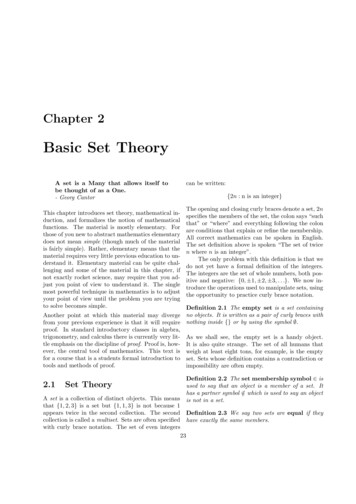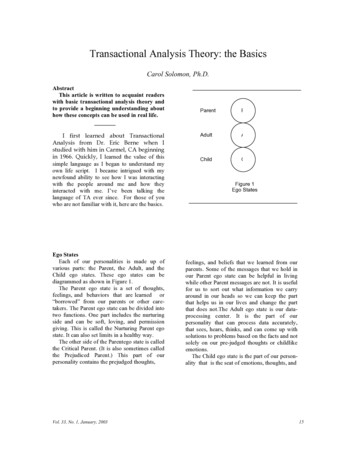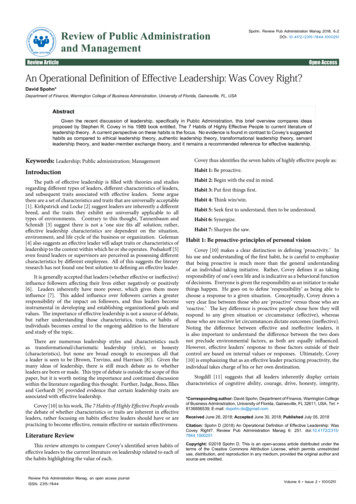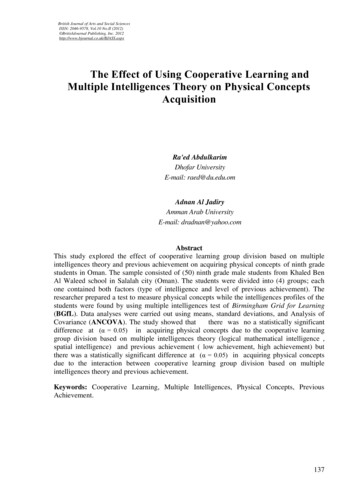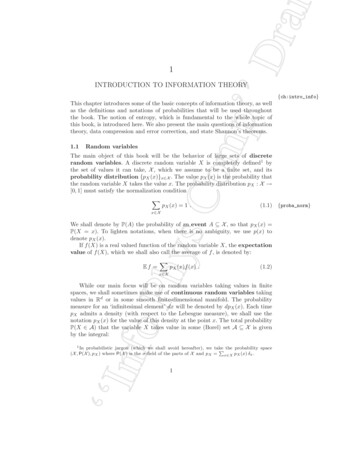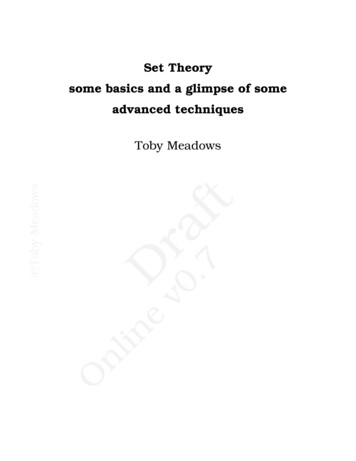
Transcription
Set Theorysome basics and a glimpse of someadvanced techniquesOnlineDv0 ra.7 ftc Toby MeadowsToby Meadows
inenlODv0 ra.7 ftc Toby Meadows
3READ ME:These notes are still drafts: there will be typos; there may be errors; and I plan to augment them.tI plan to update this document on my website:Dv0 ra.7 fhttps://sites.google.com/site/tobymeadows/.Unless you’ve already come from there, it could beworth looking there for a more recent version ofthis document.nlineAlso, if you do spot any problems or there’ssomething you don’t like or understand, I’d like tohear about it. Please drop me an email at:toby.meadows@gmail.com.Oc Toby MeadowsThat said, they should be complete enough to beuseful and I hope you find them so.
ContentsPreliminary remarks5789101831tChapter 1. Axioms & representations1.1. ZF C1.2. The story of the axioms1.3. Representing structures1.4. Some remarks333438424649Part 2. Overview of advanced set theory52Chapter 3. Advanced topics in set theory3.1. Inner models, constructibility & CH3.2. Outer models, forcing and CH535464ineDv0 ra.7 fChapter 2. Backbones & problems2.1. Ordinals2.2. Transfinite induction and transfinite recursion2.3. Cardinals2.4. Cantor’s theorem - there are larger infinities!2.5. Infinite Cardinals & the Continuum hypothesis (CH)87878789Bibliography91nlChapter 4. Advanced topics in foundations4.1. Large objects, palpable problems & determinacy4.2. Multiverse theories, is there more than one mathematicaluniverse?4.3. Hamkins4.4. Steel4.5. WoodinOc Toby MeadowsPart 1. Some basics of set theory47677
PRELIMINARY REMARKS5Preliminary remarksFirst, I am going to concentrate on set theoretic foundations. I do this,partly, because it’s my background and passion; however, set theory arguably makes the most plausible claim to providing a foundation of mathematics of any approach currently on the market. Moreover, as philosophers,it is quite likely that you have used set theoretic tools for model theoreticpurposes in introductory logic courses - although they may have been hidden in the background. As such, I’m hoping there’s something to build on.Dv0 ra.7 ftThe second restriction is with regard to how deep we dig. If we were tocover all of the material discussed in these notes in proper detail, it wouldprobably take around 400 pages (and I usually underestimate). With this inmind I’ve adopted a strategy that I hope will work: we are going to start veryslow and then just leap into the abyss. The plan is as follows: Session 1: Introduce the axioms of set theory and show how mathematical and semantic structures can be represented there. Session 2: Introduce ordinals, transfinite recursion, cardinals, Cantor’s theorem and the continuum hypothesis.ineThese two sessions will be quite detailed and will probably feel a little dry.My goal here is to introduce enough of the language and machinery of settheory that: 1) you’ll be familiar with basic set theoretic notation and whereit comes from; and 2) you’ll gain some familiarity with powerful set theoretictools which can make light work of logical problems in the truth literature.nlWe then move on to: Session 3: Inner models, outer models, and large cardinals. Session 4: The multiverse and indefinite extensibility.Oc Toby MeadowsMy goal in these notes is to introduce both some of the basic tools in thefoundations of mathematics and gesture toward some interesting philosophical problems that arise out of them. Of necessity, there is only so much wecan do in such a short space - so I’ve made some important restrictions inscope.In these sessions, I won’t be able to give all the details of the constructionsused, but will hopefully be able to give you a feel for: what is going on;the overarching strategies involved; and the philosophical problems thatemerge. I strongly believe that, while a technical background is helpful,
PRELIMINARY REMARKS6OnlineDv0 ra.7 ftc Toby Meadowsthere is a lot that philosophers with different specialties can offer to thefoundations of mathematics - just like any other area of philosophy. WhileSession 3 covers work from the 50s through to the 90s, Session 4 will looka something very new and an old chestnut.
Part 1OnlineDv0 ra.7 ftc Toby MeadowsSome basics of set theory
CHAPTER 1Axioms & representationsThis week we are going to cover:the axioms of ZFC;Russell’s paradox;the language of set theory; andrepresenting structures and models using sets.nlineDv0 ra.7 ftMost of our time this week will be spent building up the language of settheory and in so doing gaining familiarity with its axioms. We shall workour way up from the sparse foundation to representing structures for a toylanguage and arithmetic.Oc Toby Meadows 8
1.1. ZF C91.1. ZF C1.1.1. The set up. In one sense set theory is very simple.1.1.1.1. The language of set theory. The language of set theory L consists of just a single two place relation symbol .1.1.1.2. The axioms of ZF C. Here they are: x y z(z x z y) x y)Foundation x( y y x z(z x w(w x w / z)))3.Pairing x y z (x z y z)4.Union x z y w(y w w x y z)5.Powerset6.Separation7.Replacement x0 . xn ( y !z(ϕ(y, z, x0 , ., xn ) u w y(y w z(z u ϕ(z, y, x0 , ., xn )))8.Infinity x( y y x z(z x {z} x)9.ChoiceDv0 ra.7 ft2. x y z(z y w(w z w x)) x0 . xn w y z(z y z w ϕ(z, x0 , ., xn ))ine x( y(y x z(z y)) y z(y x z x w(w y w z)) u y(y u !z(z y)))nlWith just these tools, we can do anything that people do in the mathematicsdepartment. But this is also pretty intimidating if you haven’t seen thesebefore. While set theorists tend to think of them as very natural and obvious- good candidates for axioms - it can take a little while to see this. Moreover,I should add that the naturalness and truth of these axioms is sometimesa point of philosophical contention (see e.g., [Potter, 2004]), although theseviews are outliers in mathematics.Oc Toby Meadows1. Extensionality
1.2. THE STORY OF THE AXIOMS10The plan for this week is to introduce each of the axioms through a kind ofnarrative which will hopefully provide some understanding of their role andfunction. My presentation owes a lot to the first chapter of Kunen [2006].1.1.1.3. Defined relations and terms. The first thing we might note is thatwhile it’s impressive that set theory can work with just a single relationsymbol, , this makes it very difficult for humans to read and understand.To alleviate this difficulty, we introduce a number of defined: relations; and termsinto the language.Here is our first example of this:t z(z x z y).Dv0 ra.7 fThis is a relation and we’ve defined it in the sense that it may be eliminatedfor its definiendum wherever it occurs. For this reason, we don’t need toregard it as being a genuine part of the language of set theory, although it isobviously very useful to have around.We’ll define an example of a term in a little while. Since a term works likea name (or constant symbol), we need to know that the name actually pickssomething out. This is a little more technical.1.2. The story of the axiomsine1.2.1. Extensionality & Foundation. We start with two axioms whichmight be described as regulative in the sense that they don’t tell us whatsets are out there; but rather tell us what they must be like.nl1. Extensionality x y z(z x z y) x y)Informally, the axiom of extensionality tell us that if sets x and y have exactlythe same members, the x and y are actually the same set.Oc Toby MeadowsD EFINITION 1. Let us say that x is a subset of y, abbreviated x y, ifSo it says that sets are extensional; unlike, say, properties which are often treated as intensional. For example, taking Quine’s classic (and likelyproblematic) example, the property of being renate (having a kidney) and
1.2. THE STORY OF THE AXIOMS11the property of being cordate (having a heart) are distinct properties havingdistinct intensions; but the respective sets of objects satisfying each theseproperties are identical. This is usually regard as fundamental to the concept of set: non-extensional set theories are very rarely explored.The axiom of foundation also plays a regulative role. As its name suggests,it says that the sets, in particular the membership relation , are wellfounded.2. Foundation x( y y x z(z x w(w x w / z)))t if x is non-empty (i.e., has a member); then it has a -least member (i.e., there is some z x such that everymember of x is not a member of z).Dv0 ra.7 fE XAMPLE 2. Suppose x is a set consisting of the elements y0 , y1 , y2 , .; andsuppose that1y0 3 y1 3 y2 3 .It is clear that x is non-empty. Then Foundation tell us that there is some zwhich is the -least member of x. Fix such a z.By our definition of x, z must be yn for some natural number n. But thenyn 1 z, which contradicts the fact that z is supposed to be the -leastmember of x.ineR EMARK . This example shows us that Foundation forbids the existence ofthe kind of set x defined. Such a set is often known as an infinite descending -chain.nlE XAMPLE 3. Suppose x is a set whose only member is x; x x and for all y,y / x. Then x is clearly non-empty. Then using Foundation fix some z suchthat: z x; and z is the -least member of x.1Oc Toby MeadowsA little less formally, it says, that:The 3 is a shorthand giving us the inverse relation. Thus we havex y y 3 x.
1.2. THE STORY OF THE AXIOMS12Since the only member of x is z, we can see that z x. But this means thatx is the -least member of x and so w(w x w / x).But using x for w and the fact that x x, we see that x / x. This a contradiction.R EMARK . The upshot of this example is that Foundation tells us that thereis no set x whose only member is x.t1.2.2. Getting sets, Russell’s paradox and Separation. So far we cannot even say that a single set exists. To get things moving, we’ll simply addan axiom, which we can remove later on, if we like. x x xDv0 ra.7 f0. Set existenceThis just says that there is a set. It’s not very exciting and we’re going toneed more than just this to get things done.Why not just say any set we can define exists? For example, we mightconsider the following axiom.nline . Naïve comprehension y x(x y ϕ(x))where ϕ(x) is any formula of L with at most xfree.The idea here is that to any way of describing the necessary and sufficientconditions for membership, we allocate a set to those conditions: the setof things satisfying those conditions. Strictly speaking, this is an axiomschema not an axiom. It stands for the infinitely many instances where aformula of L is substituted in.For well known reasons, this does not work.T HEOREM 5. (Russell) Any theory including naïve comprehension is inconsistent.Oc Toby MeadowsE XERCISE 4. Can a set x have more than one -least member? If so, give anexample.P ROOF. Assume we are working in a theory that includes the axiomschema of naïve comprehension. We shall prove a contradiction.
1.2. THE STORY OF THE AXIOMS13Let ϕ(x) : x / x; so ϕ(x) says that x is not a member of itself.Using ( .) fix an r such that for all xx r r / r.But then we haver r r /r x0 . xn w y z(z y z w ϕ(z, x0 , ., xn ))Dv0 ra.7 f6. SeparationtFortunately, ZF C provides us with a simple way around this. We still wantto be able to use descriptions to pick out sets, but rather than letting anymembership conditions pick out a set, we are going to use those conditionsto separate out those elements satisfying the conditions from a set that wealready established to exist.It’s probably a little easier to take in, without the stream of x0 . xn out thefront.26.’ Separation w y z(z y z w ϕ(z))Informally, this says that given any set w, there is a set y consisting ofexactly those elements z of w such that ϕ(z). We separate out the ϕ’s from w,to get y.nlineUnlike naïve comprehension, there is no known proof that systems includingseparation are inconsistent. For Gödelian reasons, we cannot do much better than this, other than to note that this system has been used extensivelyfor over a hundred years.We can also tell from this that there is no universal set.T HEOREM 6. There is no x such thatOc Toby Meadowswhich is impossible.2 y(y x y y).In fact, with the rest of ZF C in the background, they are equivalent.
1.2. THE STORY OF THE AXIOMS14P ROOF. Suppose for a contradiction that there such an x. Then by theaxiom of separation, we get the following set{z x z / z}.But for all ww {z x z / z} w /wsince x trivially contains all the sets. Thus, {z x z / z} is Russell’s setwhose existence is a contradiction. We are now in a position to define our first term.T HEOREM 7. There is exactly one set x which has no members.t(1) The existence of such a set; and(2) The uniqueness of such a set.Dv0 ra.7 f(Existence) By (0.) fix some set x such that x x. Let ϕ : y y / x. Then by(6.) fix some z such that for all sets uu z u x y y / x.Clearly z has no members.(Uniqueness) Suppose w also has no members. Then for all u we haveu z u wand so by extensionality w z: thus, there is only one set with no members. ineSince, Theorem 7 tells us that there is exactly one empty set, we are warranted in introducing a name to denote this element.nlD EFINITION 8. Let the emptyset, abbreviated , be the set that is empty.Theorem 7, tells us that the term is well-defined.Oc Toby MeadowsP ROOF. There are two parts to this claim:E XERCISE 9. Let x be an arbitrary set. Verify the following or provide acounter-example:(1) ;(2) x ;
1.2. THE STORY OF THE AXIOMS15(3) x;(4) x x.We can also introduce another useful term at this point. This term is moresophisticated than a mere name in that it has - what we might think of as multiple inputs.If we consider Axiom (6.) we can use extensionality to see that the set ysupplied by the axiom must be unique.P ROPOSITION 10. x0 . xn w !y z(z y z w ϕ(z, x0 , ., xn ) for any ϕ(z, x0 , ., xn )from L .P ROOF. Exercise. (Hint: Suppose there were two such sets.) t(1) sets x0 , ., xn , w; and a(2) formula ϕ(z, x0 , ., xn , w) from L Dv0 ra.7 fthere is a unique y containing the elements of w which satisfy ϕ(z, x0 , ., xn , w).We now describe a term which takes these inputs and denotes such a w.D EFINITION 11. Let{z w ϕ(z, x0 , ., xn )}be the set of those z w such that ϕ(z, x0 , ., xn ).This term is given to us directly by the axiom of separation. It is used verycommonly in set theory as it is - it seems - easier to wield.ineHowever, even with Axioms (0.) and (6.) in place, we still cannot guaranteethe existence of kinds of sets we might find useful.nl1.2.3. Pairing, Union and Powerset. These next axioms give us somesets which one would naturally think must exist. As opposed to Extensionality and Foundation, they are not so much regulative in that they tell usthat new sets exists. More like Separation, there is a sense in which theytake inputs and return new sets: they also have the form. But unlikeseparation, which has a linguistic/schematic element, the kinds of new setswe get are quite simple to understand. I’ll call these combinatorial axiomsfor this reason.Oc Toby MeadowsNow Proposition 10, tells that given an inputs of:The first of these is the axiom of pairing.
1.2. THE STORY OF THE AXIOMS16 x y z (x z y z)3. PairingInformally, this says that given any two sets x and y there is a set whichcontains both x and y as members.Moreover, using extensionality, we can show that there is exactly one set zcontaining exactly x and y.P ROPOSITION 12. For all x and y, there is a unique w whose members are xand y. t(Uniqueness) Use Extensionality to show it is unique.Dv0 ra.7 fThis fact licenses us to augment our language with another useful term.D EFINITION 13. For all x and y, let {x, y} be the set containing just x and y.E XERCISE 14. Is {x, y} {y, x}? Prove it or provide a counterexample.Our next combinatorial axiom is the Axiom of Unions. x z y w(y w w x y z)4. UnionInformally, this tells us that for any set x there is a set z which contains allof the members of members of x.ineThat’s still a bit of a mouthful. It’s probably easier to get the idea with apictorial example.nlE XAMPLE 15. Given a set x that has elements w0 , w1 , w2 each of which haselements described belowxOc Toby MeadowsP ROOF. (Existence) Use Pairing to get a set z containing x and y. UseSeparation to get{u z u x u y}. HHH w0HHw1w2y00 y01 y02 y10y20 H HH
1.2. THE STORY OF THE AXIOMS17there is a set z such thatz XHXXX HHXy00 y01 y02 y10 y20In a similar fashion to before, we can introduce a term which takes a set xand returns exactly the members of members of x.P ROPOSITION 16. For all x there is a unique set y containing exactly the members of members of x.P ROOF. Exercise. (Similar to previous examples)Sx be the set of members of members of x.Dv0 ra.7 ftE XERCISE 18. Show that for any finite collection of set x0 , ., xn , there is aset x containing just x0 , ., xn as its members, thus showing that the term{x0 , ., xn } is well-defined. (Hint: use induction on the size of the collection.You’ll need to use both Pairing and Union.) From what point of view, so tospeak, did establish this.Our final combinatorial axiom is the Axiom of Powersets.5. Powerset x y z(z y w(w z w x))Informally, this axiom tells us that for every set x there is a set y whichcontains all the subsets of x.ineE XAMPLE 19. Let z {x0 , x1 } be a set. Then there exists a set y whichcontains the following sets: , {x0 }, {x1 }, {x0 , x1 }.nlAs with the other combinatorial axioms, we may define a new and usefulterm.P ROPOSITION 20. For any set x there is a unique y containing exactly thesubsets of x.Oc Toby MeadowsD EFINITION 17. Let D EFINITION 21. Let the powerset of x, abbreviated P(x) be the set of subsetsof x.
1.3. REPRESENTING STRUCTURES181.2.4. Some other useful notation. The following definition contains anumber of other common notations used in set theory.D EFINITION 22. (i) Let x y be the set of members of either x or y.(ii) Let x y be the set of members of both x and y.(iii) Let x\y be the set of members of x but not y.E XERCISE 23. Definition 22 is informal. Show that the definition do providewell-defined sets. (Hint: Use Separation.)tThere are only three axioms to go. But we already have enough tools to doquite a lot. Now our story will have a little bit of to-and-fro. We’re goingto work up to representing semantic models and mathematical structures we’ll build up our language a little more and we’ll introduce the remainingaxioms as we need them.Dv0 ra.7 f1.3.1. Ordered pairs, relations & functions. One of the first things wemight note about sets is that they are different from lists. A list has anordering which allows us to pick, say, the third element of the list - a set isnot like this.However, there is a way that we can construct sets which behave like lists,or as we shall call them sequences. We shall start by making an objectwhich represents a list with just two members. This known as an orderedpair. (Critically, this is exactly the object that mereological systems cannotform, leaving them incapable of providing a mathematical foundation - unlessaugmented.)ineAgain, we shall introduce a term to represent ordered pairs. The method isa little different from the previous cases.nlT HEOREM 24. There are formulae π0 (v0 , v1 ) and π1 (v0 , v1 ) of L such that forany x0 and x1 there is a unique y such that:(1) π0 (x0 , y) z(π0 (z, y) z x0 ); and(2) π1 (x1 , y) z(π1 (z, y) z x1 ).Oc Toby Meadows1.3. Representing structuresR EMARK . Intuitively, y is the set representing the ordered pair of x0 and x1 ;π0 (x0 , y) say that x0 is the first member of the ordered pair; and π1 (x1 , y) saysthat x1 is the second member of the ordered pair.
1.3. REPRESENTING STRUCTURES19P ROOF. Really, what we want to do here is find an object to do the joband then find formulae that will allow us to decode that object. There aremany (infinitely many) ways of doing this, but by convention we the standardapproach.Given x0 and x1 , consider the set{{x0 }, {x0 , x1 }}.Let π0 (x0 , y) say that: y has no more than two members; and there is an element of y having (exactly) one member and this is x0 .Dv0 ra.7 ft(1) y has two members, u0 and u1 where(a) u0 has one member and u1 has two members;(b) there is a unique x0 such that x0 u0 and x0 u1 ; and(c) x1 u1 but x1 6 x0 .(2) y has one member and x1 y.Given arbitrary x0 and x1 is should be clear that there is only one y such thatπ1 (x1 , y) and that for such a y we must have y {{x0 }, {x0 , x1 }}. This gives usthe uniqueness of y.Moreover, it should also be clear that given y {{x0 }, {x0 , x1 }} there can onlybe one z such that π0 (z, y) and such a z x0 . Similarly for π1 . This gives usthe uniqueness of x0 and x1 as required. Now we introduce a term to our the ordered pair of x0 and x1 .ineD EFINITION 25. Let the ordered pair of x0 and x1 (in that order), abbreviatedhx0 , x1 i be {{x0 }, {x0 , x1 }}.nlR EMARK . Note that we could have already defined this term before provingTheorem 24. We already have the tools for this in using our pairing notation.We need Theorem 24 rather to prove that hx0 , x1 i does what we want it to:i.e., that we can recover x0 and x1 from it in their correct order.Oc Toby MeadowsLet π1 (x1 , y) say that either:E XERCISE 26. Why does the second clause of the definition of π1 (x1 , y) inTheorem 24 need two clauses: one for the case where y has two elements;and the other for when y just contains a single element? (Hint: considermaking the ordered pair hx, xi.)
1.3. REPRESENTING STRUCTURES20E XERCISE 27. Define an ordered triple. Define an ordered n-tuple.R EMARK 28. Given x1 , ., xn we write hx1 , ., xn i to denote the ordered n-tupleof x1 , ., xn .E XAMPLE 29. Let A {a, b, c} be a set. (Notice that I’m using a capital Romanletter A to represent a set. This is a common convention in set theoretic practice. It’s usually done when most of the other sets under consideration areelements of A. But it’s also quite a loose convention. When doing set theory,one usually takes it that everything is a set, so it doesn’t matter too muchwhat kind of letters we use.)Dv0 ra.7 ftNow consider a binary relation R on the objects in A. Suppose that thefollowing list of sentences describes how R relates the object in A: aRb, bRc, aRa and cRc.Then we can just as easily represent this relation using a set of orderedpairs: {ha, bi, hb, ci, ha, ai, hc, ci}.Let us call this set R† . Then it is clear thatxRy hx, yi R† .ineThe lesson we take from this example is that relations can be representedby sets. Moreover, as set theorists we take this a step further.D EFINITION 30. A relation is a set of ordered n-tuples.nlSo we are no longer saying that relations are merely represented by setsbut that they are sets. This can be a vexing philosophical issue (see Potter[2004]), but we’ll try not to get stuck here at the moment.Oc Toby MeadowsWe now use this tool to represent relations. The ability to do this is crucial toset theory’s ability to provide a foundation for semantics and mathematics.We start with an example.We now describe how to represent functions. Intuitively, a function is like amachine which takes some inputs and then gives an output. A function has a domain of inputs which it can take; and a range of outputs that it returns.
1.3. REPRESENTING STRUCTURES21However, it’s not too difficult to see that we can represent function usingrelations. Let’s start with another example:E XAMPLE 31. Suppose we have a function f (f is everyone’s favourite letterfor functions) and suppose it takes a single input of an element of A {a, b, c}and returns a value also from A. Then we can describe the function’s behaviour with simple table:fa ab ac aBut we could also represent this situation with a list of sentences as follows:Dv0 ra.7 ft f (a) a, f (b) a and f (c) a.And just as we did with relations, we can represent this list usinga set {ha, ai, hb, ai, hc, ai}which we might call f † . Then we clearly havef (x) y hx, yi f.ineOnce again, the lesson to be taken here is that any function can be represented by a set. Moreover, such a set is a special kind of relation: for anyinputs to the function, there can only be one output. Just as with relations,as set theories we say merely that functions can be represented by sets, butthat they are sets.nlD EFINITION 32. A n-ary function f (i.e., a function taking n inputs) is a (n 1)ary relation (i.e., set of (n 1)-tuples such that for any x1 , ., xn there is atmost one y such thathx1 , ., xn , yi f.Oc Toby MeadowsSo f is a simple function which just returns a no matter what is given to it.Such functions are known as constant functions.1.3.2. The axiom of replacement, products and finite sequences. Sonow with relations and function in place we are just about ready to representmodels and structures. However, we’re going to pause for a moment anddiscuss a subtle point with some deep philosophical ramifications.
1.3. REPRESENTING STRUCTURES22Some of you will have noticed that my talk about terms in the earlier sectionswas a lot like talk about functions. As I described them, terms and functionstook (possibly multiple) inputs and returned an output. For example, givenx and y, the term {x, y} was the pair of x and y. So should we understand{·, ·}as a function taking sets and returning another set.The problem is that Definition 32 does not allow this since it demands thata function be a set.P ROOF. This is trivial once we have the next axiom (the Axiom of Replacement) in place, but it’s a little fussy here. (Essentially, we making anotherversion of the Russell set.)Dv0 ra.7 ftTo make things a little simpler we’ll consider the function {·} which takes aset and returns what is known as its singleton.Suppose for a contradiction that {·} is a function. Then as a function, it isthe set{hx, {x}i x x}.Call this set P . Then by Separation there must be a setR {z P x hx, {x}i z z / x}.Consider the set Q hR, {R}i. Clearly Q P .Suppose Q R. Then by the definition of R, Q / R.ineBut then since Q / R and Q P , we have Q R: contradiction. nlWe might say that a term like {·, ·} is too big to be a function. In a similarsense, the universal set was too big to be a set.Nonetheless, it’s also handy to treat the universal set somewhat like a setand treat {·, ·} somewhat like a function. To this end, we introduce whatwe shall call classes. Classes are like sets and indeed can have the sameextension as sets, but they can also be larger. We shall allow that any set ofconditions determines a class (although we know that it may not determinea set.Oc Toby MeadowsL EMMA 33. {·, ·} is not a function.
1.3. REPRESENTING STRUCTURES23Thus if we write {x ϕ(x)} we know there is a class corresponding to that,although there may not be a set. For example,{x x / x}is a class but not a set. Such classes are known as proper classes. The existence of these entities are philosophically vexed. Are they out there? Maybethey’re just pluralities Boolos [1984]? We shall try to adopt an agnostic attitude to them by noting that we could always remove talk of proper classesand just make do with the formula that defines them.Thus, whenever we writey {x ϕ(x)}tHowever, we shall also find it convenient to have a notation for referring tothese entities. Thus, we shall refer to proper classes by bold roman capitals,e.g., A, B, F . . . .Dv0 ra.7 fNote that we can also represent terms using this notational convention.Thus there is a proper class function F such thatF {z x y hx, y, {x, y}i}exactly corresponding to the term {·, ·}. To apply this function, we shall writeF(x, y) {x, y}.This now brings us to the Axiom of Replacement. x0 . xn ( y !z(ϕ(y, z, x0 , ., xn ) u w z(z w y(y u ϕ(y, z, x0 , ., xn )))ine7. ReplacementnlP ROPOSITION 34. Given sets x0 , ., xn , a (class) function F(v0 , ., vn ) and a setu there is a unique set w which is the set of values of F for inputs x1 , ., xn andy from u.D EFINITION 35. Given sets x0 , ., xn a function F(v0 , ., vn ) and a set u letOc Toby Meadowswe could also just write ϕ(y).{F(y, x1 , ., xn ) y u}.T HEOREM 36. For all sets A and B, there is a unique set C consisting of of allthe ordered pairs ha, bi where a A and b B.
1.3. REPRESENTING STRUCTURES24P ROOF. We make two appeals to the Axiom of Replacement.First let F(v0 , v1 ) be the function such that for x, yF(x, y) hx, yi.Then by Replacement, we see that for any a, there is a set{F(a, b) b B} {ha, bi b B}.First let G(v0 ) be a function such that for a AG(a) {ha, bi b B}.Then by the Replacement again, there is a settand by union there is a set[[{G(a) a A} {{ha, bi b B} a A}Dv0 ra.7 f {ha, bi a A b B}which is what we wanted. D EFINITION 37. Given sets A and B, the Cartesian product of A and B, denoted A B is the set of ordered pairs ha, bi with a A and b B.R EMARK . Regarding why this is called a product, consider the sets A {a1 , a2 } and B {b1 , b2 , b3 }. Verify that the size of A B is 6; i.e., the productof the sizes of A and B.ine1.3.2.1. Notational conventions, proving relations exist, defining functions.Whenever we define a relation R we remark on what R is a relation on. Thus,we writeR A B.nlFor a function f , we remark that it is a function from its domain to someother set, its codomain. Thus, we writeOc Toby Meadows{G(a) a A}f : A B.Note that the codomain of a function is not necessarily its range. It can beany superset of the range. Strictly this information is not contained in thefunction itself.
1.3. REPRESENTING STRUCTURES25However, it is extremely useful to follow these conventions. Th
Part 2. Overview of advanced set theory 52 Chapter 3. Advanced topics in set theory 53 3.1. Inner models, constructibility & CH 54 3.2. Outer models, forcing and CH 64 Chapter 4. Advanced topics in foundations 76 4.1. Large objects, palpable problems & determinacy 77 4.2. Multiverse theories,



